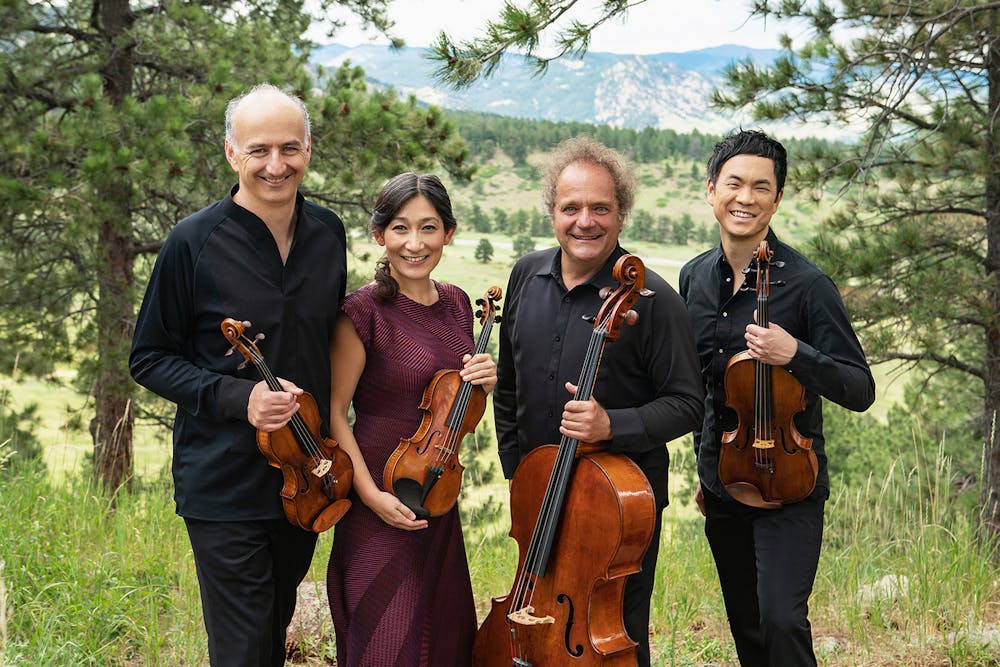The arrival of the Takács Quartet, heralded by The New York Times as “one of the world’s greatest string quartets,” has been highly anticipated since the group’s genre-bending performance as a part of the Middlebury Performing Arts Series nearly two years ago. The group made its return to campus with two performances at the Mahaney Arts Center, on Friday, Jan. 19 at 7:30 p.m. and Sunday, Jan. 21 at 2 p.m..
The group’s 28th appearance on campus since 1994, last weekend’s program consisted of the entire Bartók string quartet cycle, with quartets one, three and five being played on Friday and quartets two, four and six on Sunday. These six pieces are among the most highly regarded twentieth-century chamber music compositions.
As the audience took their seats for the second performance on Sunday, the mid-afternoon sun beamed through tall triangular windows, painting the walls with soft light. Without preamble, the quartet members entered, took their seats and began.
The first of the afternoon’s three string quartets, Béla Bartók’s Quartet No. 2, takes inspiration from early-19th-century Hungarian folk music and serves as an exploration of the transmission of peasant tunes from Central Europe and North Africa into modern music. Originally composed in Budapest between 1915 and 1917, the piece’s folk-inspired atmospheric elements set a benchmark by which the rest of Bartók’s work is contextualized. The Takács Quartet fiddled furiously, playing for 90 minutes with an animation, vigor and spirited precision that brought to life a piece of Hungarian folk history within the walls of Robison Hall.
After the din of applause had died down, the musicians retook their seats, bows at the ready. Composed a decade after his second, Bartók’s Quartet No. 4 is a five-movement amalgamation of the artist’s years of field research. The piece consisted of a slow, tender movement, sorrowful and sweet, bookended by hasty, lively allegro. Like any good recipe, these powerful symphonic ingredients are interwoven through a binding agent in the form of two folk-driven scherzos.
Quartet No. 4, at times cacophonous, at times delicate, was a spellbinding highlight of the performance. The musicians, spritely and wild, did more than play, infusing the music with character and soul. At moments the Takács’ work bordered on comedy, their expressive postures and swaying limbs conveying both the lightheartedness and the drama of Bartók’s work.
Founded in 1975, the Takács Quartet is the child of four students at Budapest’s Franz Liszt Academy. Of the four founding members, the cellist András Fejér, 68, is the final musician who remains in the group today, in the quartet’s 49th year of performance. This weekend, Fejér was accompanied by Richard O’Neill on viola, and Edward Dusinberre and Harumi Rhodes on violin.
The quartet has won numerous awards over the years, including a Grammy, four Gramophone Awards, a Presto Music Recording of the Year Award and three Japanese Record Academy Awards. The group is also the first string quartet to be awarded the Wigmore Hall Medal and be inducted into Gramophone’s Hall of Fame.
“I was overwhelmed,” remarked one community member in the audience.“You felt that they physically felt the music.”
As the setting sun began to cascade through the stained windows, the warm spotlight gained an intensity that added to the production of the Takács Quartet’s performance. Each quartet was received by the audience with enthusiastic applause and standing ovations.
For their final piece of the afternoon, the musicians performed Bartók’s Quartet No. 6. Composed in Switzerland as a mostly autobiographical reaction to the deterioration of life in Eastern Europe following the onset of World War II and completed shortly after the death of his mother, the piece is widely regarded as the composer’s most celebrated. The composition is intense, becoming progressively slower and more melancholic with each successive movement.
The audience, a mix of young ears and gray-haired listeners, sat enraptured by the group’s tender notes and weeping strings. There was a brief silence before the audience roared their approval, and the performance was over.
Before leaving the stage, Dusinberre gave a parting message to the Robinson Hall audience.
“Chamber music is all about relationships,” Dusinberre explained. “Not just between the musicians but also with the audience.”

Charlie Deichman-Caswell ’24 (he/him) is a Photo Editor and Contributing Writer.
Charlie is an Environmental Studies major with a concentration in Anthropology, and French minor. He enjoys athletic activities such as climbing and soccer, as well as other hobbies like photography and creative writing. In his spare time, he enjoys hiking and spending time outdoors with friends, reading, watching movies, and generally chilling out.




